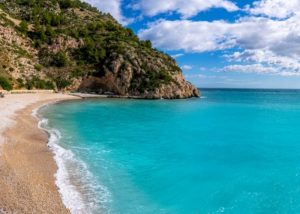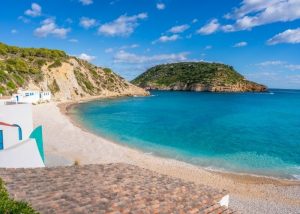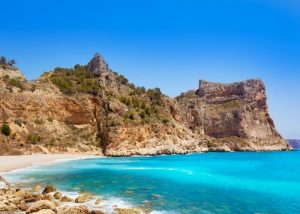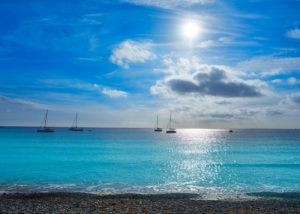PROVINCIA DE ALICANTE – The coast of the province of Alicante is called ‘the white coast’, Costa Blanca. Contrary to popular belief, white does not refer to the white of the beaches, but to the white of the almond blossoms that flourish here in early spring.
Yet Costa Blanca is very popular among tourists from the north of Europe not without reason. Furthermore, this is the same among Spaniards themselves, who flock to their second homes when it gets too hot in the interior to spend their summers. The Mediterranean climate, the turquoise water, and the wonderful beaches along a coastline of more than 240 kilometres guarantee a wonderful stay.
While some beaches in Alicante are best avoided during peak season (roughly the third week of July to the end of August), they are quiet enough to visit before and after that time. Stay away from the high season on days with good weather, even on Sundays. Then it is usually very busy everywhere. We describe here several beaches for inspiration.
 Cala Baladrar, Benissa
Cala Baladrar, Benissa
Baladrar Bay in Benissa is known as the ‘beautiful gateway to the Mediterranean’. Benissa is less than half an hour’s drive from Benidorm in the Marina Alta. That is the area with the most beautiful landscapes in the entire province of Alicante. Sheltered behind a high cliff, the bay was once part of the ‘Sesters’ canyon and consists of two parts: Baladrar and Goleta. The water here is shallow and crystal clear. That makes the bay ideal for snorkeling and diving.
Cala de la Granadella, Javea

Very close to Cala Baladrar is Cala Granadella in the municipality of Jávea or Xàbia in Valencian. A beautiful cove between high rocks with azure blue water and white sand. The bay is accessed by a road of the same name. In high season it is very busy here because it is not that big. When it’s not that hot yet, you can walk the beautiful route along the Castell de la Granadella route. There is also a lot of snorkeling in the clear water.

Cala Barraca or Portitxol, Jávea
Another beautiful place in Jávea. Cala Barraca or Portitxol is a cove with a rustic appearance (gravel sand and rock). The bay is located between Cap Prim and Cap Negre and can be reached by car via the Cabo de la Nao road or on foot from the Mirador de la Cruz. The views are beautiful. Not only because of the beautiful colour of the clear water but also because the island of Portitxol is opposite the Barraca. It is known for its great botanical and archaeological value.
Cala del Moraig, Benitachell

We are still in the Marina Alta area but now stop at Cala del Moraig. In high summer, you probably prefer to avoid this place. All those people come here for a reason. The beach is heavenly, the rock formations impressive, and the turquoise blue water more than attractive. In addition, you will find the Cueva de Los Arcos, a cavity formed by several arches in the sea. The capacity of this bay is limited, so get there early.
Raco del Conill, Villajoyosa
 Between the cliffs of ‘Colada de la Costa’ in the municipality of Villajoyosa (Marina Baja) is the naturist bay ‘Racó del Conill’. It is only 3 kilometres from the centre of Villajoyosa and the beach consists of pebbles mixed with sand. The beach, which is only 160 metres long, is split by a large and flat rock projecting into the sea. It has traditionally been a nudist beach because of various hidden spots, but you can also go there in swimwear. Snorkeling enthusiasts will find a beautiful underwater world around the ‘rock tongue’.
Between the cliffs of ‘Colada de la Costa’ in the municipality of Villajoyosa (Marina Baja) is the naturist bay ‘Racó del Conill’. It is only 3 kilometres from the centre of Villajoyosa and the beach consists of pebbles mixed with sand. The beach, which is only 160 metres long, is split by a large and flat rock projecting into the sea. It has traditionally been a nudist beach because of various hidden spots, but you can also go there in swimwear. Snorkeling enthusiasts will find a beautiful underwater world around the ‘rock tongue’.
Tabarca Beach, Alicante

Tabarca Beach is located on the island of the same name and is the only inhabited island in the Valencia region. It is small at 1,800 metres long and 400 metres wide. Most tourists come for a day and sail there from Alicante, Benidorm, or Santa Pola. The mini archipelago consists of four islands: Tabarca, La Cantera, La Galera, and La Nao. Since 1986, the area has been designated a marine reserve, thanks in part to the undersea grasslands with Posidonia oceanica. The beaches are beautiful.


